|
Click Here to return to Boston Illustrated Content Page Click Here to return to Previous Chapter |
 (HOME) |
|
Click Here to return to Boston Illustrated Content Page Click Here to return to Previous Chapter |
 (HOME) |
|
IV.THE CENTRAL DISTRICT, Continued.
Two of the oldest church-buildings in the city are left within the limits of the Central District, surrounded by business structures, only one of them occupied as a house of worship. The Old South Society, whose new edifice is described elsewhere, was the third Congregational Society in Boston, and was organized in 1669, in consequence of a curious theological quarrel in the First Church. The first Old South meeting-house, erected in 1669, on the corner of what are now Washington and Milk streets, stood for sixty years. It was of cedar, and had a steeple. It was taken down in 1729, when the present building was erected on the same spot. This now historic meeting-house is perhaps the most noted church edifice in the United States. It is internally quaint and interesting, although the old pulpit and the high box-pews have been removed, and the double tier of picturesque galleries are partly overlaid with portraits and other antiques from the historic families of New England. But a tablet which stands above the entrance on the Washington Street side of the tower gives concisely the main facts. The Old South is frequently mentioned on the pages devoted to the history of Boston before and during the Revolution. When the meetings of citizens became too large to be accommodated in Faneuil Hall, then much smaller than now, they adjourned to this church. Here Joseph Warren stood and delivered his fearless oration, on the anniversary of the massacre of March 5, 1770, in defiance of the threats of those in authority, and in the presence of a marshalled soldiery. Here were held the series of meetings that culminated in the destruction of the detested tea, on which the determined colonists would pay no tax. In 1775, the British soldiers occupied this meeting-house as a riding-school, and place for cavalry drill. They established a grog-shop in the lower gallery, which they partially preserved for spectators of their sport. The rest of the galleries were torn down, and the whole interior was stripped of its woodwork. The floor they covered with about two feet of dirt. In 1782 the building was thoroughly repaired and put in very much its late condition. The first Election sermon was delivered in the Old South Church in 1712, and the ancient custom was observed up to the year 1872. In 1876 the Old South Society sold the church, to be ton down and replaced by commercial buildings. But certain Bostonians, loath to see such a sacrilege, bought the ancient edifice, and the land on which it stood, for about $430,000, a large portion of which has been raised and paid, by private efforts. The church is now a loan museum of curious historical relies, Revolutionary weapons, flags, quaint old furniture, portraits of the New England fathers, and other interesting objects. It is open daily, and the entrance-fees go toward the preservation-fund. 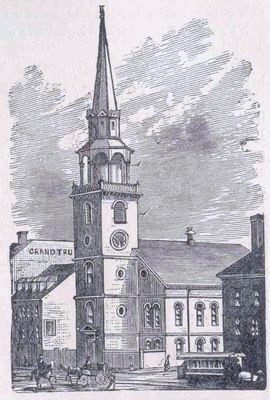 Old South Church before the Fire. The Province House was on Washington Street near the Old South, nearly opposite the head of Milk Street, and had a handsome lawn in front, embellished with oak-trees. It was a dignified brick building three stories high, with a long flight of stone steps leading up to a portico, from which the viceroys used to address the people. The edifice was erected in 1679, and in 1715 was bought by the Province as a residence for its governors, being well fitted therefore by the size and splendor of its interior and the agreeableness of its surroundings. Here Shute, Burnet, Shirley, Pownall, Bernard, Gage, and Sir William Howe held their vice-regal courts. After the siege of Boston the building was occupied by State offices, and in 1811 it was given in endowment to the Massachusetts General Hospital, whose trustees leased the estate to David Greenough for ninety-nine years. The new lessee erected a block of stores in front, and the Province House ultimately became a negro-minstrel hall. In 1864 it was burned, and only the walls were left standing, which are now covered with mastic, and serve as the exterior of a new structure. The old Province House was charmingly described by Hawthorne, in his “Twice-Told Tales.” The land along Washington Street, between Milk Street and Spring Lane, belonged originally to John Winthrop, who built his house thereon, in order to be conveniently near the spring of clear water from which Spring Lane derives its name. In the winter of 1775 Winthrop’s house was pulled down by the British troops, to be burnt at their camp-fires. Under its thatched roof the governor often entertained the envoys and chiefs of the adjacent Indian tribes, and conciliated them by diplomatic feasts. The remains of the Puritan saint are in the King’s Chapel Cemetery; his statue (by Greenough) is at Mount Auburn, a duplicate of which stands in Scollay Square, Boston. His estate on Washington Street was bequeathed by Madam Norton to the Old South Church, which is the richest in the country, except Trinity Church in New York. His descendants are still living in honorable station. King’s Chapel, standing at the corner of School and Tremont Streets, also has its history, hardly less interesting than that of the Old South. It is, as is well known, the successor of the first Episcopalian church in Boston. There were a few of the early settlers in the town who belonged to the Church of England. In 1646 they asked for liberty to establish their form of worship here “till inconveniences hereby be found prejudicial to the churches and Colony;” but they were very decidedly rebuffed, and no more was heard of the matter for many years. The Church of England service was, however, introduced by the chaplain to the commissioners from Charles II., in 1665, and from that time there was little hindrance to its use. Nevertheless, it was not until twelve years after this that a church was actually formed, and not until 1686 that steps were taken to erect a building to accommodate it. Governor Andros in that year greatly offended the consciences of the Old South people by determining to occupy the Old South for an Episcopal Church, and by compelling them to yield to him in this matter, though very much against their will. However, about that time, the church was built on a part of the lot where stands the present building. It is not possible to ascertain how the land was procured for the purpose; and some have believed that Andros appropriated it in the exercise of the supreme power over the soil which he claimed by virtue of the delegated authority of the king. The new church was occupied in July, 1689. In 1710 the building was enlarged, but by the middle of the century it had fallen to decay, and it was voted to rebuild with stone. The present building was first used August 21, 1754. During the British occupation of the town it was left unharmed. While the Old South Meeting-House was undergoing repairs of the injuries sustained in its occupation as a military riding-school, the society of King’s Chapel gave to that society the free use of its church. When the Old South people returned to their own house, the proprietors of King’s Chapel voted to return to their old form of worship, with extensive alterations in the liturgy, adapting the Church of England service to the Unitarian doctrine. And thus the first Episcopal Church became the first Unitarian in Boston. Adjoining this ancient church is the first burial-ground established in Boston. It is not exactly known when it was first devoted to the burial of the dead. There is some dispute over the question whether Mr. Isaac Johnson, one of the most prominent of the colonists, and also one of the first to pass away, was or was not buried here. It is, however, certain that this was the only graveyard in Boston for the first thirty years after the settlement. The visitor to this yard will be apt to notice the very singular arrangement of gravestones alongside the paths. They were taken from their original positions years ago, by a city officer, who was certainly gifted with originality, and reset, without the slightest reference to their former uses or positions, as edgestones or fences to the paths. There are many very old gravestones in this yard. These, at least, date back to the year 1658. One of these stones has a history. At some time after the interment of the good deacon it commemorated, the stone was removed and lost; but it was discovered in 1830 near the Old State House, several feet below the surface of State Street. It is of green stone, and bears this inscription : — HERE: LYETH
THE: BODY : OF: MR. WILLIAM: PADDY: AGED 58 YEARS : DEPARTED THIS : LIFE: AUGUST : THE 1658. On the reverse is this singular stanza of poetry: — HEAR . SLEAPS . THAT
BLESED . ONE . WHOES . LIEF GOD . HELP . VS . ALL . TO . LIVE THAT. SO . WHEN . THEM. SHALL. BE THAT . WE . THIS . WORLD. MUST . LIUE WE . EVER . MAY . BE . HAPPY WITH . BLESSED . WILLIAM . PADDY. A great many distinguished men of the early time were buried in this enclosure, and several of the tombs and headstones still bear the ancient inscriptions. The tomb of the Winthrops contains the ashes of Governor John Winthrop, and of his son and grandson, who were governors of Connecticut. All three, however, died in Boston, and were buried in the same tomb. Not far away is a horizontal tablet, from the inscription on which we learn that “here lyes intombed the bodyes” of four “famous reverend and learned pastors of the first church of Christ in Boston,” namely, John Cotton, John Davenport, John Oxenbridge, and Thomas Bridge. In this abode of the dead are also the graves and the remains of many of the most famous men of the early days of Boston, — the Sheafes, the Brattles, and the Savages, among others. The next to the oldest stone remaining in the yard is that of Mr. Jacob Sheafe, one of the richest merchants of his time, who died in 1658. This burying-ground has not been used for interments for a very long time. It is occasionally opened to visitors. In the granite building on Tremont Street beyond King’s Chapel, and adjoining the old burial-ground, is the Massachusetts Historical Society. It has a library of 27,000 volumes, 60,000 pamphlets, and many rare manuscripts. Many ancient portraits adorn the walls, while relics of Washington and the Puritan governors and of King Philip, the chair of Governor Winslow, and the swords of Governor Carver, and Church the Indian-fighter, are carefully preserved here. The most interesting of the portraits are those of Increase Mather and Sebastian Cabot. Among the manuscripts are voluminous writings of Governor Winthrop, Governor Hutchinson (eleven volumes), the historian Hubbard, Governor Jonathan Trumbull of Connecticut, the Rev. Dr. Jeremy Belknap, and other New England worthies, and the manuscript of Washington’s address to the officers of the American army. Another rare curiosity is a copy of the Indian Bible, which was translated by the Apostle Eliot, and cannot now be read by any person living. The innermost room is occupied by the Dowse Library, a bequest of nearly 5,000 richly bound books, precious by reason of their rarity and antiquity. The society is the oldest of its kind in America, and includes among its membership many of the most honored names of New England. This building is open daily. In the rear of the Historical Building and King’s Chapel was the ancient Latin School, from which School Street derived its name. It was founded in 1634, and among its students were Franklin, Hancock, Sam Adams, Cotton Mather, Robert Treat Paine, and Sir William Pepperell. About the year 1750 the school was removed to the present site of the Parker House, and here Harrison Gray Otis, Robert C. Winthrop, Horatio Greenough, Charles Sumner, and others who became renowned, conned their lessons through the long days of their youth. A little farther east, near the site of the City Hall, was the house of Isaac Johnson, one of the first settlers of Boston; and James Otis, the Revolutionary orator, lived close by. Farther down School Street was the ancient church of the French Huguenots, built in 1704, and presented with a Bible by Queen Anne, and with a communion-service by Mr. Faneuil; and on the north corner of School and Washington Street, is one of the oldest buildings now standing in the city. This is the “Old Corner Book Store.” It was built in 1712 by Thomas Crease. It was at first an apothecary store on the ground floor kept by the owner, and dwelling above. Several shopkeepers succeeded him in following years. In 1828 Carter and Hendee occupied it for a bookstore, and to that use it has since been devoted. In 1832 Allen & Ticknor, the lineal ancestors of the present firm of Houghton, Muffin & Co., took the stand and this house held it under the successive managements of William D. Ticknor, Ticknor, Reed, & Field, and Ticknor & Fields, until 1465. It is now occupied by Damrell & Upham, the successors of A. Williams & Co. The Old Corner Store stands in very nearly its original form, and is one of the best and m o s t substantial examples of a style of architecture that has gone wholly out of vogue. 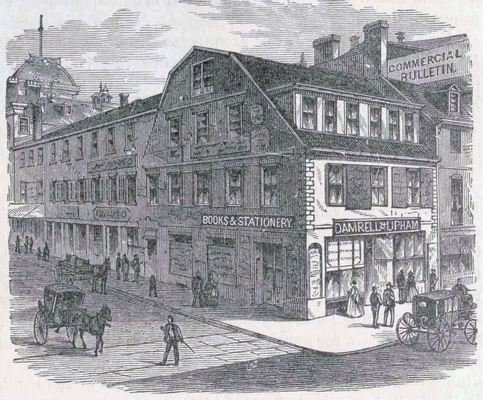 Old Corner Bookstore. The Parker House, on School Street, near the corner of Tremont, was the first hotel established in the city on the European plan, and has for years been one of the most prominent of the many leading hotels of Boston. The late proprietor of the Parker House, Mr. Harvey D. Parker, began in a small way in another building, and gained a reputation for providing the best that the market afforded, which the present Parker’s has never suffered itself to lose. The house is elegant externally, and sumptuously furnished within. It is patronized very extensively by persons travelling for pleasure, and is a universal favorite with visitors as well as citizens. Its prosperity has been so great that the proprietors several years ago were obliged to make an addition of two stories to their original building, and to purchase an estate on the corner of Tremont Street. This newer portion consists of a six-story marble building of fine architectural appearance. Parker’s has a large public dining-room, a café, and several attractive private dining-rooms. Directly opposite the Parker House, on the corner of Washington and Beacon streets, is the imposing New Albion, occupied by Houghton & Dutton. 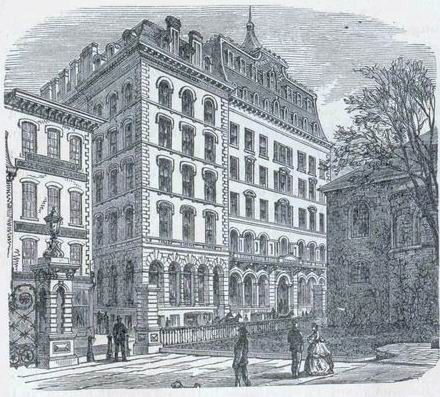 The Parker House. Young’s Hotel is a short distance from Parker’s, fronting on a court in the rear of the Rogers Building, which stands on Washington Street opposite the head of State. The hotel extends to Court Square and Court Street. The portion occupying the corner of Court Square and Court Street was built in 1881—82. It is seven stories high, and is constructed of light sandstone, highly ornamented. In the addition is the ladies’ restaurant, the entrance to which is through a noble vestibule on the Court Street side. This dining-room is a hundred feet long and thirty-one feet wide. It is elaborately and richly decorated, and sumptuously furnished. At the end is a high, ornamented mantel and open fire-place built up of the Chelsea tile. There are other large dining-rooms and a café for gentlemen, the main dining-room being in the older portion of the house, and itself finely decorated, though not so lavishly as the ladies’ dining-room. Young’s is now one of the largest of the hotels in the city. Like Parker’s it is conducted on the European plan. The present proprietor is Joseph Reed Whipple, formerly of the Parker House. It was established by Mr. George Young, long a popular landlord, in 1845, and succeeded “Taft’s Coffee House.” The building adjoining the new portion of Young’s Hotel, on Court Street, is the Sears Building. This occupies the corner of Court and Washington streets, fronting on the latter, directly opposite the Old State House. It is built in the Italian-Gothic style of architecture, and the external walls are constructed of gray and white marble. It is occupied by banks, insurance companies, a score or more of railroad companies, engineers, treasurers of companies, etc. This elegant structure is one of many belonging to the Sears estate. It was built in 1868—69 and cost about three quarters of a million dollars. The other corner of Washington and Court streets is occupied by a building belonging to F. L Ames, now (February, 1890) in course of construction. On Tremont Street, next the Historical Society’s building, and near the head of the street, is the Boston Museum, by far the oldest of the places of amusement in Boston. In 1841, Mr. Moses Kimball organized and opened the “Boston Museum and Gallery of Fine Arts,” at the corner of Tremont and Bromfield Streets. In connection with the museum was a fine music-hall, where the drama very soon found a home. The present building was erected by Mr. Kimball in 1848, and the first entertainment was given in it on the 2d of November in that year. The museum proper was for many years large and interesting, and occupied numerous alcoves in the large hall on Tremont Street, and several capacious galleries. Now, however, the museum is of little importance, and the theatre is the main attraction. This has been several times entirely reconstructed, and is at present one of the handsomest, most complete, and brightest playhouses in the city. It is finely decorated and upholstered; and much care is given to the ventilation. Au excellent stock company presents the best of dramatic novelties, making the Museum a first class comedy theatre; and the “star” and “combination” systems are occasionally used. The Museum is a great favorite with all classes of patrons of the drama. It has been under the management of Mr. R. M. Field since 1863; and the veteran comedian Mr. William Warren, was a member of its company, with the single exception of the year, from 1847, until his retirement at the close of the winter season of 1882—3. 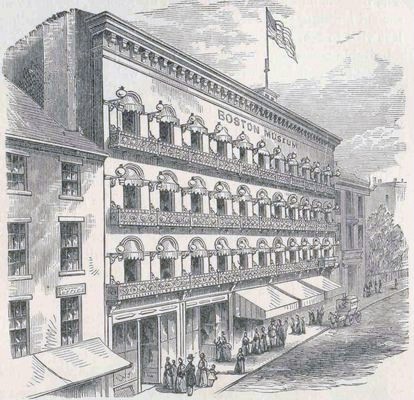 Boston Museum. On the corner of Tremont and Court Streets, where a fine brown stone structure called the Hemenway Building now stands (see cut on page 87), until 1883 stood an old building which was conspicuous among its neighbors as the house in which General Washington stayed during his visit to Boston in 1789, when Hancock turned him the cold shoulder. On Tremont Row, in this vicinity, was the court-quarter of old Boston, where stood the houses of Governor Endicott, Sir Harry Vane, and Richard Bellingham, and the eminent divines Cotton, Oxenbridge, and Davenport. On Tremont Street just beyond School Street, south, and opposite the Tremont House, — which has been described in the previous chapter, — is Tremont Temple. It occupies the site of the old Tremont Theatre, and is one of the best known halls in the city for public assemblies of all kinds. The present is the third building on this site known as Tremont Temple. The first was the Tremont Theatre remodelled, in 1843, for the establishment of a popular Baptist Church. This building was destroyed by fire in March, 1852. The next year a new building was completed which in turn was burned in August, 1879. The present building was completed in October, 1880. It was in the hail of the second building that Mr. Charles Dickens gave his readings in Boston on his last visit to America, and it was selected on account of its great capacity and admirable acoustic properties. The present audience-room is one hundred and twenty-two feet long, seventy-two feet wide, and sixty-six feet high, with deep, encircling galleries. It can seat comfortably 2,600 persons. It is provided with a fine Hook and Hastings organ. Beneath the large hall is a smaller one, known as the Meionaon, with an entrance through a long passage-way from Tremont Street. The Temple is occupied on Sundays by the Tremont Temple Baptist Church, which was established in 1839, and for which the hail was originally constructed. Several Baptist missionary and publication societies also have their headquarters in the building. The great hail has been celebrated, of late years, as the place where the Rev. Joseph Cook has discussed theological and secular questions in the “Monday Lecture” before large audiences. A fine piece of architecture is the Horticultural Hall on Tremont Street, between Bromfield Street and Bosworth Street. It was erected by the Massachusetts Horticultural Society, and is one of the most perfectly classical buildings in the city. It is built of white granite, beautifully dressed, and the exterior is massive and elegant in proportion. The front is surmounted by a granite statue of Ceres; and on the north and south buttresses of the second stories are ideal statues in granite of Flora and Pomona by Martin Milmore. The lower floor of the building is occupied for business purposes, and above are two halls, not very large, yet adapted not only to their original purpose, for the meetings and exhibitions of the society, but for parlor concerts, lectures, social gatherings, and fairs. 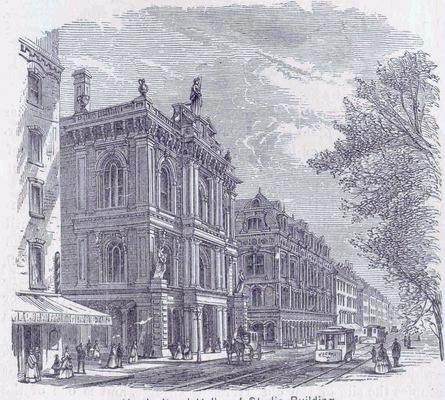 Horticultural Hall and Studio Building. The Studio Building, shown in the accompanying illustration, stands on the opposite corner of Bromfield Street. This building was at one time a headquarters of the artists of Boston, but now many of them are located elsewhere. Besides the devotees of art, there are many private teachers of music and the languages in the Studio Building, and a few of the rooms are occupied as bachelors’ apartments. Standing on Tremont Street, at the head of Hamilton Place, and looking down the place, one may see the side entrance to a plain and lofty brick building without ornament or architectural pretensions of any sort. This building is the Boston Music Hall, one of the noblest public halls in the world. It was built by private enterprise, and first opened to the public in 1852. The acoustic properties of the hall are perfect.. As Dr. Holmes has said, it is “a hind of passive musical instrument, or at least a sounding-board constructed on theoretical principles.” The hall is 130 feet in length, 78 in breadth, and 65 in height. T h e height is half of the length; the breadth is six tenths of the length, the unit being thirteen feet. The fine statue of Apollo, the admirable casts presented by Miss Charlotte Cushman and placed in the walls, and, above all, the magnificent statue of Beethoven, by Crawford, that stands on the platform, deserve the attention of every visitor to the hall. For more than thirty years the most of the concerts of high character have been given here: the grand oratorio performances of the Handel and Haydn Society, the oldest musical organization in the United States, and the leading choral society in the country; the Symphony Concerts of the Harvard Musical Association; the deservedly popular concerts of the Boston Symphony Orchestra, established in 1881 through the liberality of Henry L. Higginson, which furnishes twice each week during the winter season the choicest music at a low price; the occasional concerts of the Apollo, Boylston, Cecilia, and other singing clubs; and those of individual artists, who, from Ole Bull and Parepa to Joseffy, have been heard within these walls. The great organ, long one of the attractions of the hall, was removed in 1884. Beneath the Music Hall is a small hall known as Bumstead Hall, the entrance to which is from the main entrance to the building from Winter Street. This is used principally for rehearsals. Not far from the Music Hall, on Washington Street between West and Boylston Streets is what might quite properly be called the “theatre quarter” of the city. Here, on the west side of the street, are the Boston, Bijou, and Park theatres, and on the east side the Globe theatre; while just beyond Boylston Street is the World’s Museum, Menagerie, and Aquarium. 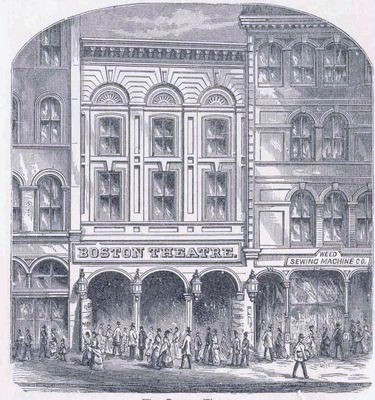 The Boston Theatre The Boston Theatre is the largest regular place of amusement in New England, and is in many respects one of the finest. It was built by a corporation composed of leading citizens in 1854, and was opened on the 11th of September of that year, under the management of Mr. Thomas Barry. There is a stock company connected with this theatre, but there are frequent “star” performances during the season, awl this is the house usually engaged for the representation of Italian, German, French, and English Opera. Most of the great American actors, and many distinguished foreign actors and actresses, have appeared upon this stage. Jefferson and Owens, Booth and Forrest, Fechter and Sothern, McCullough, Ristori, Salvini, Janauschek, Irving, Ellen Terry, and a host of others whose names are famous in the annals of the stage, have here delighted the Boston public; while of opera-singers may be mentioned Nilsson, Lucca, Parepa Rosa, Kellogg, Phillipps, Patti, Gerster, and Hauck. Here, too, the gorgeous spectacular plays that have their seasons of prosperity have been presented in very complete form; the greatest and most successful fairs ever held in Boston for charitable objects have been given here; and the vast auditorium was the scene of the balls given in honor of the Prince of Wales and the Grand Duke Alexis. The new Gaiety Musee and Bijou Theatre is just beyond the Boston Theatre. It occupies the site of the Gaiety Theatre, which flourished for several years, and which was constructed from a somewhat famous hall long known as the Melodeon. The Bijou is a dainty theatre, highly ornamented, and richly decorated. The prevailing shade of the interior decorations is a coppery hue, which lights up brilliantly. The house is so arranged that every seat command a good view of the stage. There is but one spacious balcony, and two private boxes, which are removed entirely from the stage. The proscenium arch is of the horse-shoe form, and the arrangements of the stage are modern in all respects. The principal entrance to the auditorium is through what is called the annex, an addition built in 1888. The house was first opened on the evening of December 11, 1882, with a performance of Gilbert and Sullivan’s “Iolanthe,” which enjoyed a long run during the first season. It is now conducted by Keith and Batchelder, as a theatre for light opera and variety performances. In this “theatre quarter,” just beyond the Bijou, the Adams House looms up majestically. Its finely finished marble front terminates in three pyramid towers, and it rises seven stories. It is one of the largest and best hotels in the city, famous especially for the excellence of its cuisine. It is conducted on the European plan. George G. Hall is proprietor. On its site long stood the Lamb tavern built in 1745. The Park is a small theatre, well arranged, and inviting in appearance. It was constructed from Beethoven Hall, and was first opened to the public on the evening of April 14, 1879. The dimensions of the auditorium are: sixty-three feet from the stage to the doors, sixty feet wide, and fifty feet high. The floor is divided into orchestra stalls and parquet, and orchestra circle; the first two rows of the first balcony are called the balcony, and the seats behind them the dress-circle; and the second balcony is the family circle and gallery. The house seats about 1,180, and it is so admirably arranged that all the seats command a good view of the stage. On either side of the stage are private boxes, attractively upholstered and provided with most comfortable chairs. The main entrance to the theatre is through a broad and handsome vestibule, and there are ample exits, so that the house can be quickly emptied of a crowded audience. The Park has no stock company, but its entertainments are furnished by “stars,” and leading New York dramatic companies. John B. Schoeffel is the manager. The Globe Theatre is one of the most attractive of the play-houses of the city. The original theatre on this site was built in 1867 for Mr. John H. Selwyn, by Messrs. Arthur Cheney and Dexter H. Follett, and was at first known as Selwyn’s Theatre. Colonel Follett subsequently disposed of his interest to Mr. Cheney. After two delightful seasons of comedy under Mr. Selwyn’s management, Mr. Charles Fechter became manager, and was in turn succeeded by Mr. W. R. Floyd. On Mr. Selwyn’s retirement the name of the theatre was changed to the Globe. In May, 1873, on the morning of Decoration Day, the theatre was destroyed in the extensive fire on Washington Street. For a year after the site remained unoccupied, but in 1874 Mr. Cheney, with the cooperation of one hundred and fifty gentlemen, who paid $1,000 each for the right to one scat each during the eighteen years’ lease, rebuilt it in an enlarged form, and it was duly opened on the 3d December of that year. Mr. Cheney died in 1878, and for a brief season the theatre was conducted by Mr. John Stetson, who had, for a short time preceding Mr. Cheney’s death, conducted it in conjunction with the latter. Then the house was closed for a season, and subsequently, in October, 1880, Mr. Stetson obtained a lease for ten years. Thereupon he freshened the theatre and added several improvements. The auditorium is sixty feet high, and of the usual horseshoe form. It has, besides the parquet, two galleries and an intermediate row of mezzanine chairs. The stage is probably the most perfect one in the country, being furnished with all approved appliances for the perfect setting of scenery. A departure, and it is believed the first, has been made from the otherwise universal practice of constructing stage floors, this being entirely level. The painted drop-curtain is admired by many, as well as the rich decoration and tasteful use of colors on the walls and ceiling, and the elegant drapery of the boxes. Beside the main entrance on Washington Street, there is a handsome one from Essex Street, which runs to the eastward from the former thoroughfare. On Essex street, years ago, Gilbert Stuart lived and painted. In later years Wendell Phillips lived here, near the corner of Chauncy, and only removed in 1882, when his house was taken down to make way for the extension of Harrison Avenue. His home until his death in 1884 was in Common Street, near by. 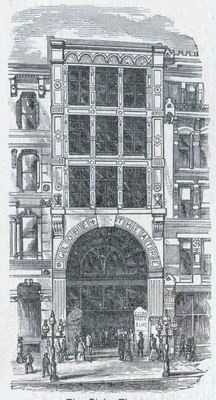 The Globe Theatre |